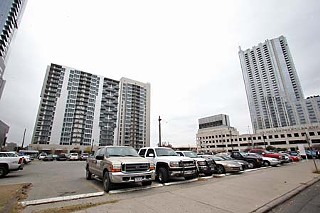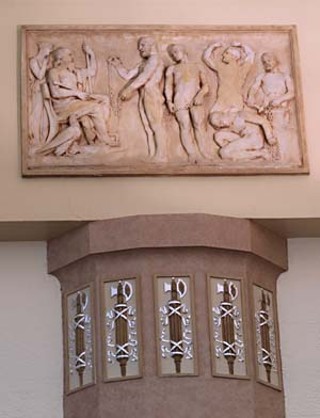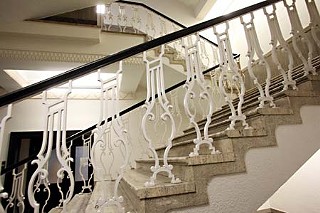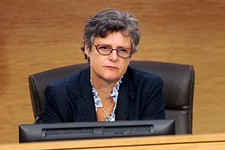The Sky's the Limit
County buys AMOA block for a new 'hundred-year' courthouse
By Jordan Smith, Fri., Dec. 24, 2010

Building a new courthouse, says Travis County Judge John Dietz, is "really kind of a once-in-a-century deal." That's essentially true for Travis County, which has been using the same civil courthouse – with two modest renovations – for the last 80 years.
With the historic Heman Marion Sweatt civil courthouse – which until recent years also contained the county's criminal courts, now next door – operating at 40% over capacity, last week the county announced its plan to begin the next hundred years with the construction of what will become, according to county estimates, a 538,000-square-foot civil courthouse. Presuming the county's contract on the land closes as expected, the building will be built between Third and Fourth Streets at Guadalupe Street, just south of Republic Square Park – that is, on the Downtown lot originally designated as the courthouse tract in 1839, when the city was first laid out (as Waterloo) by Judge Edwin Waller.
On Dec. 14, county commissioners voted to enter into a contract to buy that tract, for $21.75 million, from its current owner, the Austin Museum of Art. The price tag is hefty and so is the project that county officials, including the county's presiding judge, Dietz, envision – a project that they've been working on for most of the last decade. "Seven years ago I sat and thought, 'Do I really want to do this?,' because it's like a very long campaign," Dietz said last week, sitting in the jury suite (which doubles as a conference room) attached to his 250th District Court. "In one sense it seems like it's moving at glacial speed; in another respect, it's happening [quickly] because there's so much to do."
Indeed, although much planning and thinking about judicial program needs has already been done, the county still must get literal community buy-in to the project – through approval of a multi-million-dollar bond issue – before a shovel of dirt is moved. Dietz is optimistic: "I'm pretty confident we're going to turn out something pretty cool here."
Resident Rodents
There is no doubt in the minds of county officials and the daily users of the courthouse – myriad judges, an army of clerks, miscellaneous staffers, law enforcement personnel, and of course hundreds of civilian litigants – that Travis County needs a new civil courts building. The Sweatt building, at 11th and Guadalupe, was originally erected in 1930. It was expanded modestly in 1958 with additional court space and again in 1964 – when the area population was a quarter of what it is now, notes County Judge Sam Biscoe – to add new jail space. That was an awkward-looking renovation to the building's north side which, in Dietz's judgment, ruined the stylish "Texas moderne" architecture and "art deco symmetry" of the original building.

Even including those two additions, says Dietz, the usable inside square footage is roughly 75,000 square feet. According to the county's numbers, the civil courts alone use nearly 50,000 square feet. That means everyone else – including the busy Precinct 5 Justice of the Peace, the probate court, and the clerk's office – is shoehorned into the remaining space. It makes for interesting working conditions. During an impromptu tour last week through the "dungeon" – a first-floor side office containing files of civil cases – Dietz pointed out that the file stacks run floor to ceiling, with clerks' desks wedged along the walls in the remaining usable space. Sensitive case files (those sealed by the court) occupy an old walk-in safe. The ceiling is lined with all types of wires and pipes – including the building's plumbing, which hovers just above the paper files.
And there are rats; in this office alone, staff recently trapped a family of seven. Indeed, literal courthouse rats are apparently fairly common. On the way back up the main stairs toward Dietz's third-floor office, we ran into Judge Jeff Rose, the former 353rd District judge who was recently appointed to the 3rd Court of Appeals by Gov. Rick Perry. "Tell her about your robe," Dietz says. Rose relates there was a vent above the spot where his black judicial robe hung overnight. Every morning, Rose says, he'd come in and wipe off rat hair and excrement before donning the robe again.
In all, roughly 30,000 people come through the courthouse doors each month, and the staff must annually track more than a million pieces of case-related paper (much of it stored on-site), creating a courthouse bursting at the seams. The current setup also poses security challenges: Unlike the criminal court buildings (just to the west down a steep flight of stairs), the civil courthouse has no secured entry for jail inmates – typically, men jailed for nonpayment of child support. Nor does it have special waiting areas where children and families involved in emotionally charged divorce or Child Protective Services cases can be segregated. As it is now, notes County Commissioner Sarah Eckhardt, the "warring parties" must sit side by side or face-to-face in courthouse hallways – not an ideal situation.

According to the county's estimates, the civil courts alone currently require more than 109,000 usable square feet. Overall, the county's courts – including the neighboring criminal courts and all the associated offices for clerks, staff, the law center, and dispute resolution center – actually need more than 900,000 square feet, if nonusable space is taken into account. By 2035, accounting for anticipated population growth, the county estimates that space needed for all court operations will balloon to somewhere around 1.5 million gross square feet.
'Full Circle'
Dietz first began working in the Sweatt courthouse in 1977, when he was a prosecutor, so after more than 30 years, he knows the building inside and out. Roughly seven years ago, he began to get serious about the limitations of the current courthouse. The judges joined together and talked to the commissioners, and the group began planning in earnest. Initially, says Biscoe, they considered the block across Guadalupe Street (site of the University Savings Building, which formerly housed the county's tax office) that the county already owns – but that plan fizzled because of height constraints imposed by the Capitol View Corridor restrictions.
A couple of years ago, says Biscoe, they began considering the vacant AMOA property – which just happened to be the site of the county's very first courthouse. "There were one or two other pieces of property Downtown" that the county also considered, but neither panned out. "At one, the owner didn't want to sell." The county has focused on the AMOA tract for about a year. (For more on the museum's side of the deal, see "Austin Museum of Art.")

Last week, the county was finally able to put the Guadalupe site – one of the last Downtown tracts free of view/height restrictions – under contract. County officials are excited about the prospects, says Commissioner Ron Davis, gratified they were able to outbid other interested parties, and pleased with the history of the site. The first Travis County courthouse, which also served as the jail, was on this site, built in the mid-1850s and consisting of two courtrooms and what Dietz calls "a dungeon." Within two decades, the county had outgrown the facility and built a successor on the southeast corner of 11th and Congress. That property became a state office building when the Sweatt courthouse was built in 1930 (in the 1960s the second courthouse was finally torn down, and the site has since been a parking lot). Moving the courthouse back Downtown to the original site has a certain historical symmetry for county officials. We're "right back to where we started from," says Davis. "It's full-circle."
Consider the Children
But this time, of course, there will be more than just two courtrooms, and no dungeon.
In fact, the courthouse that public officials envision will be nothing like any of the court facilities the county has yet seen. Ideally, say officials, the facility will be far more user-friendly. For starters, it will pull together elements of the county's judicial system that are currently housed in various places around the city, and it will incorporate new features that will make it more accessible to "working people," says Dietz.
For example, officials envision bringing the county's dispute resolution center to the new site, which should help the civil caseload – most of which requires at least a mediation attempt – to move more smoothly.
Having a new and much larger space would also allow the county to expand its popular Self-Help Center. The center, currently sandwiched on the split-level below the Sweatt courthouse's first floor and next to the building's small cafeteria, has three staff attorneys who are available to help individuals research and prepare to represent themselves in civil matters. Dietz is particularly proud of this office, which he says is unique in the state. Of the 50 to 75 divorce cases the county hears each month, he says, roughly 40 are filed by individuals using the center. In the county's space plans, the law library housing this office could triple in size.
County officials are additionally interested in incorporating a child-care center into the new courthouse. Creating some form of child care will not only help children involved in divorce or other cases; it will also allow jurors with child-care concerns to serve when they might not otherwise have been able to, and, similarly, it will help people with cases on any of the civil dockets who have a hard time getting to the courthouse during normal working hours because of child-care concerns.
The Long View

Still, exactly what the courthouse will look like, inside and out, is yet to be determined. Consultants have been working with officials to determine what the county's needs are – both at present and looking forward to 2035. Using population projections, they're anticipating what the civil caseload will look like more than two decades down the line – especially in the rapidly growing area of family law. With those projections in mind, the county, working with a contingent of consultants (led by Broaddus & Associates), has come up with a rough sketch of the civil courts' space needs.
In that "stacking diagram," the civil courthouse would rise to 15 or more stories; according to the county's space-needs study, the number of civil courtrooms would grow from the roughly 20 we now have to almost 35 by 2035. County officials' legwork on the proposed site included visits to other courthouses, including new facilities in Charlotte, N.C., and Orange County, Fla.
Of course, whether the county will get voter approval to move forward with the project remains to be seen. (Dietz says if voters do approve the project, it would become the largest current courthouse project in the nation, which should allow the county to attract the country's best architectural and construction talent.) The next step will be to seat a Citizens' Bond Advisory Committee – ideally that will happen in January, says Rodney Rhoades, executive manager of the county's Planning and Budget Office. From there, the cost estimates for the courthouse will be refined.
That exact cost is yet to be determined; Biscoe says the early estimates he's heard run anywhere from $150 million to $350 million. Either is a lot of money – but so was the $750,000 that the county spent on building the original Sweatt courthouse in 1930, says Dietz. That expenditure, he says, was "controversial at the time." But over 80 years, he notes, those officials might have decided the investment was actually a "good deal, costing only about $9,300 per year." In other words, he says, spending on a project like this is a matter of perspective.
Nonetheless, spending for the new civil courthouse isn't the only project on the county's plate. The courthouse is actually just one piece in the county's Central Campus master plan, a development scenario that brings most of the county government's major functions together into the city's core. For example, reworking the lot across from the Sweatt courthouse, the old University Savings Bank tract (known as Block 126, says Rhoades), into a civic center is also part of the plan – a hub not only for county offices but also, ideally, for open space, retail, and restaurants. The plan would revitalize Wooldridge Square Park, which is directly to the south of the Sweatt courthouse, and would include the restoration of the Sweatt courthouse itself.
Although the facility is now overburdened by use, it has a lot of history worth preserving, say county officials – including the fourth-floor courtroom where Heman Sweatt and his lawyer, then the future U.S. Supreme Court Justice Thurgood Marshall, fought to desegregate the UT School of Law. Ideally, says Dietz, the county would remove the 1964 addition that tacked on upstairs jail space and would take the building back at least to its 1958 look, and it would additionally restore to their original state the building's first courtrooms. It would remain a working facility, housing an expanded probate court and Precinct 5 Justice of the Peace, and the first floor would incorporate public meeting space, says Rhoades. And the original jail, in the building's top floors – known to courthouse denizens as "Alcatravis" – would become the county's history center, says Eckhardt.
But that's down the line, likely in the second phase of Central Campus bonds and construction, after the new civil courthouse facility is built. (The second phase might also incorporate the expansion of the criminal courts building, possibly tacking on an additional seven stories to the Blackwell-Thurman Criminal Justice Center that the county built just nine years ago. The criminal caseload will expand as the civil caseload does, the county expects, necessitating 14 additional criminal courtrooms by 2035, along with the expansion of the central jail that sits next door.)
That, Eckhardt says, would happen first, within the next 10 years. The county first evaluated its facilities for "critical needs," which includes, primarily, the civil courthouse facility, says Rhoades. The rest of the projects will be staged over the next 20 years. Indeed, Dietz said that he hopes the new courthouse would be complete within five to seven years.
There's a long way to go and much still unknown about how the plans for the project will play out. But Dietz is nonetheless excited. "It's tremendous," he says. "There are a lot of great things that we could do."
Got something to say on the subject? Send a letter to the editor.












